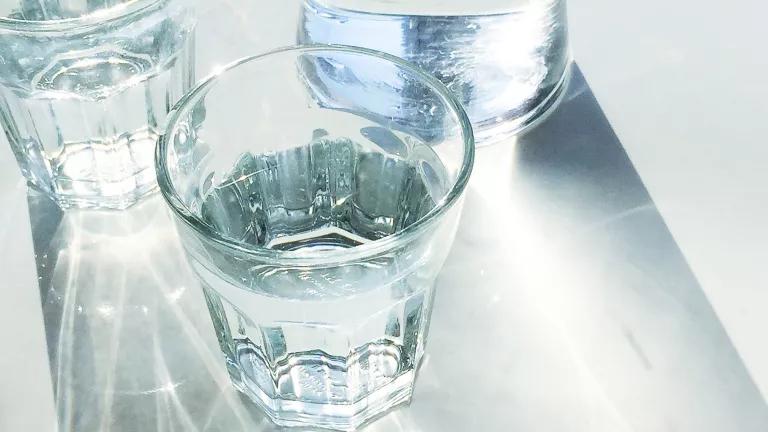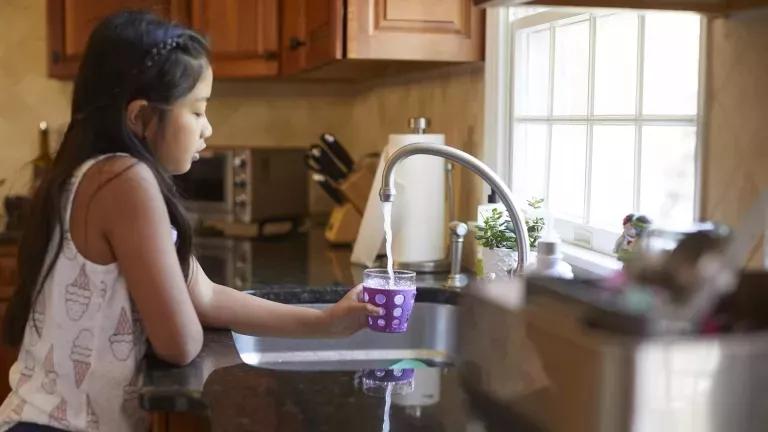
Few questions confound health-conscious conservationists more than the first one a waiter might ask at a nice restaurant: bottled or tap?
We know which is better for the environment. That's easy. Not only are millions of tons of plastic bottles clogging our landfills, but it takes 1.63 liters of water to make every liter of Dasani—and the company is doing it in drought-plagued California.
But despite those harsh realities, public concerns about tap-water quality (and, let's face it, slick marketing) have caused bottled water sales to soar over the past couple of decades. Some of those concerns are merited: NRDC reports have shown that millions of people in the United States get their water from systems detecting lead. And other health-harming contaminants, such as PFAS, atrazine, and nitrates, have also been found to be common in drinking water supplies across parts of the country.
Nevertheless, just because a bottled water company produces ads and labels that connote purity, with images of pristine glaciers and crystal-clear mountain springs, doesn’t mean that’s what consumers are getting.
How is water regulated?
It's regulated by different agencies, with different missions. The U.S. Environmental Protection Agency oversees the quality of water that comes out of your tap, while the U.S. Food and Drug Administration is responsible for ensuring the safety and truthful labeling of bottled water sold nationally. States are responsible for regulating water that is both packaged and sold within its borders (which is most of the market), but one in five states doesn't even bother.
It's important to note that the federal government does not require bottled water to be safer than tap. In fact, just the opposite is true in many cases. Tap water in most big cities must be disinfected, filtered to remove pathogens, and tested for cryptosporidium and giardia viruses. Bottled water does not have to be.
Both kinds of water are tested regularly for bacteria and most synthetic organic chemicals, but city tap is typically assessed much more frequently. For example, bottlers must test for coliform bacteria just once a week; city tap needs to be tested 100 or more times a month.
Limits on chemical pollution for both categories are almost identical. The one place where bottled water might have the edge is in the case of lead; because many older homes have lead pipes, the EPA standard for tap water is less strict—one-third of the FDA's standard for lead in bottled water.
OK—but which type of water is actually safer?
In 1999, after a four-year review of the bottled-water industry and its safety standards, NRDC concluded that there is no assurance that bottled is cleaner or safer than tap water. In fact, an estimated 25 percent or more of water sold in a plastic bottle is really just tap water in a bottle—sometimes further treated, sometimes not.
Of the 1,000 bottles tested, the majority proved to be relatively clean and pure. About 22 percent of the brands tested contained chemicals at levels above state health limits in at least one sample. If consumed over a long period of time, some of those contaminants could cause cancer or other health problems for people with weakened immune systems.
Though it's mostly safe, tap might at times also present issues—especially if you live in a rural community with a higher likelihood of pesticide runoff contamination, or if you get your water from a private (unregulated) well or live in an older home.
Under "right-to-know" provisions in the drinking water law, all tap suppliers must provide annual quality reports to their customers. You also can test your water yourself. Standard consumer test packages are available through large commercial labs at a relatively reasonable price. Call your state drinking-water program or the EPA Safe Drinking Water Hotline (800-426-4791) for a list of contacts.
Your water report will point out possible risks to health; fortunately, a home filter designed explicitly to strip contaminants will resolve most cases. If you want to take extra precautions, you should purchase filters certified by NSF International. These models are designed to filter out specific contaminants, so you can select one based on your needs. Some filters have been independently tested to remove PFAS, though they must be correctly installed and maintained to ensure they're working properly.
If I still want (or need) to buy bottled water, how do I know what I'm buying?
Even though both the federal government and most states have bottled-water safety programs, regulations don't adequately assure consumers of either purity or safety. For example, PFAS are not regulated in bottled water, and recent testing by academic researchers indicated that several brands were contaminated with these chemicals.
A few state programs (for example, those in Massachusetts and New York) maintain lists of the sources, but not all do. You can learn some information by carefully checking the label and even the cap; if it says "from a municipal source" or "from a community water system," this means it's derived from tap. If you don't find any information on the bottle, you can call the bottler or the program in your state or the state where it was packaged and ask about the source.
Could the actual bottle pose a health risk?
Recent research suggests there might be cause for concern. Chemicals called phthalates, which are known to disrupt testosterone and other hormones, can leach from the container into the water over time. One study found that water that had been stored for 10 weeks in plastic and in glass bottles containing phthalates, suggesting that the chemicals could be coming from the plastic cap or liner. Although there are regulatory standards limiting phthalates in tap, there are no legal limits in bottled water; the industry waged a successful campaign opposing the FDA proposal to set a legal limit for these chemicals.
This NRDC.org story is available for online republication by news media outlets or nonprofits under these conditions: The writer(s) must be credited with a byline; you must note prominently that the story was originally published by NRDC.org and link to the original; the story cannot be edited (beyond simple things such as grammar); you can’t resell the story in any form or grant republishing rights to other outlets; you can’t republish our material wholesale or automatically—you need to select stories individually; you can’t republish the photos or graphics on our site without specific permission; you should drop us a note to let us know when you’ve used one of our stories.
Millions of Americans drink tap water served by toxic lead pipes.
Tell the EPA we need safe drinking water!

Tell the EPA we need safe drinking water!
There is no safe level of lead exposure. But millions of old lead pipes contaminate drinking water in homes in every state across the country. We need the EPA to do its part to replace lead pipes equitably and quickly.

“Forever Chemicals” Called PFAS Show Up in Your Food, Clothes, and Home
How to Find Out If Your Home Has Lead Service Lines
How to Protect Yourself from Lead-Contaminated Water